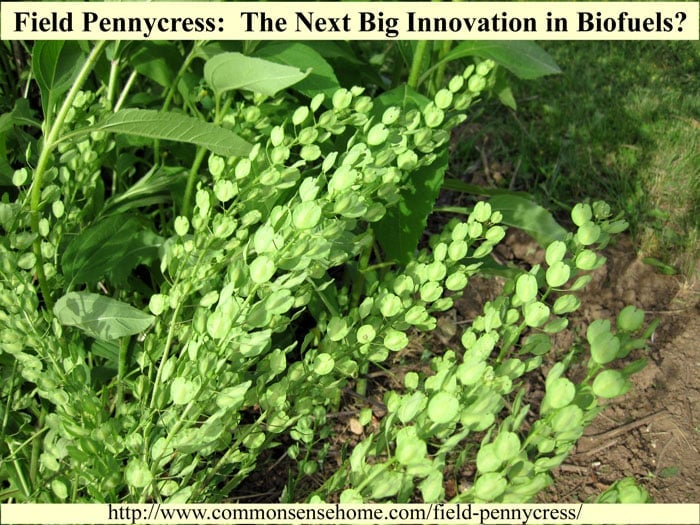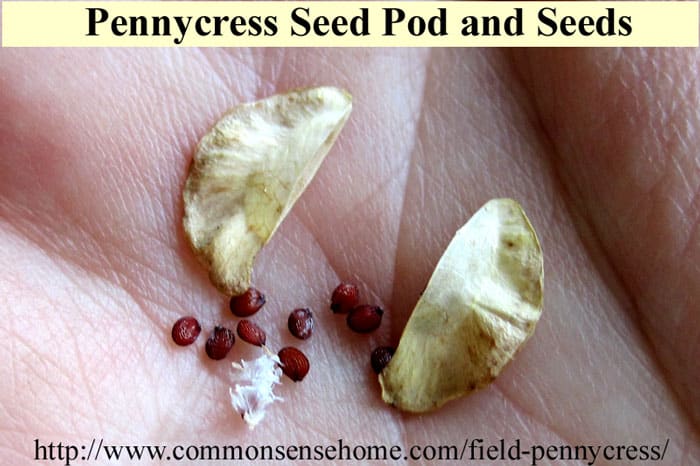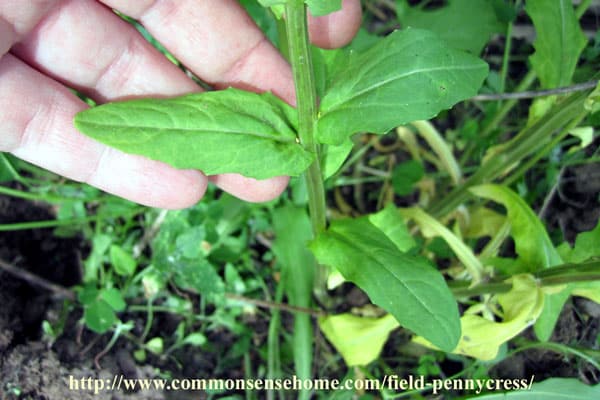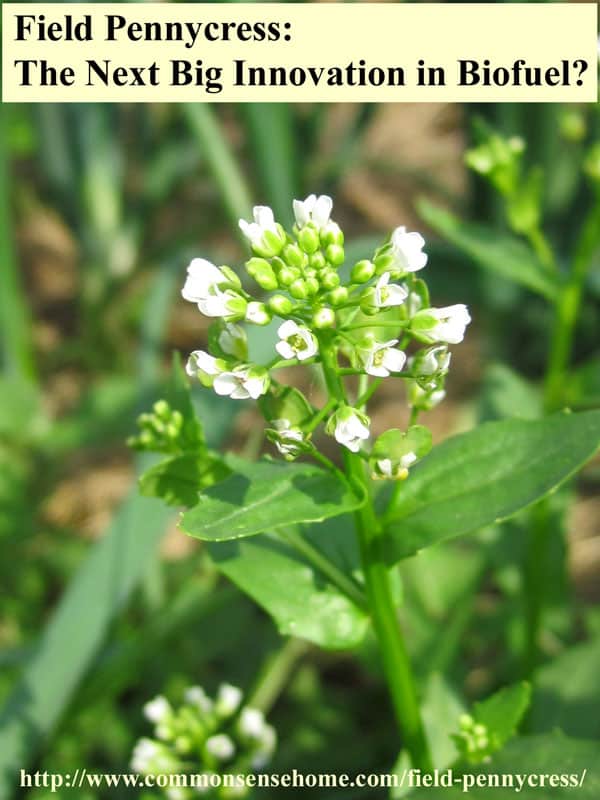Field Pennycress – Thlaspi arvense – Weekly Weeder #47

Today’s featured plant is Field Pennycress, Thlaspi arvense.
Field Pennycress is also known as Pennycress, Field Pennygrass, Field penny-cress, Frenchweed, fanweed and stinkweed. (source)
It’s in the mustard family (Brassicaeae), so it is related to common garden crops such as cabbage, cauliflower, broccoli, and kale, as well as other wild mustard family plants such as Shepherd’s Purse -Capsella bursa-pastoris – Weekly Weeder #15 and Winter Cress- Barbarea vulgaris – Weekly Weeder #20.
Range and Identification of Field Pennycress
Pennycress is native to Eurasia, near the Mediterranean, but has spread around much of the world. The USDA plant database shows it throughout most of the US and Canada, although oddly absent from Georgia. (see map). It prefers full sun and disturbed soils, and is commonly found along roadsides and trails, in garden beds and farm fields.
The plant is a winter annual. It can be planted in fall and will overwinter to produce seeds in late spring/early summer. This contributes to its potential as a biofuel. (See below.)

Plants are small to medium height, about 5-18″ (12.5-45 cm) tall, and are most easily distinguished by their small, flat, round penny-shaped seed pods, which turn from green to coppery brown as they mature. The seeds are dark brown, oval, with a point at one end. They have an interesting swirl pattern on them that reminds me of a fingerprint. In the seed pods I broke open, I found 12 seeds, six on each side, divided into two compartments by a papery membrane. The seed pods break right in half to spew seeds all over the place. The plant has a taproot, and spreads by reseeding.

Like all members of the mustard family, their pennycress flowers have four petals arranged in a cross shape. They are small, 1/4′ (.6 cm) across, and grow in 1″-2″ (2.5 – 5 cm) clusters at the end of branches. (See photo at bottom of post.) The flowers don’t have much smell, but the plant itself has mustardy odor when crushed, and a strong, somewhat mustardy/garlicky flavor.
Pennycress leaves alternate up the stem of the plant. They are lance shaped and coarsely toothed, about 2-4″ (5-10 cm) long. (See Wildflowers of Wisconsin for more information.)

Field Pennycress as Wildlife Habitat
The small white flowers are visited by pollinators, and I’m pretty sure there’s a cabbage worm at the top of the pennycress seed pods photo.
Illinois wildflowers lists faunal associations:
The nectar of the flowers attracts primarily small bees and flies. The caterpillars of some White butterflies and Pyralid moths probably feed on the foliage, including Pieris rapae (Cabbage White), Pontia protodice (Checkered White), Eustixia pupula (Pyralid Moth sp.), and Evergestis pallidata (Purple-Backed Cabbageworm Moth). Mourning Doves occasionally eat the seeds of weedy members of the Mustard family. Because the foliage has a bitter-garlic flavor, it is not a preferred food source for mammalian herbivores. When dairy cattle eat this plant, their milk develops an off-flavor.
Is Field Pennycress Edible?
You can eat it, but it doesn’t taste very good. 🙂 Seriously, like most wild greens in the mustard family, it has a very pronounced flavor. The bigger the plants get, the stronger the flavor, and once they’ve bloomed, you’d have to be really hungry. Cooking takes the edge off, although you can use very young greens in salads if you like a little extra kick. Hot radish eaters, this is the salad green for you.
The seeds are very high in oil, and have been ground to use as a mustard substitute, or sprouted to add to salads. If you’re interested in extracting oil in volume from these or any other seeds (such as pumpkin or sesame), you can invest in a hand crank expeller oil press. If you’re just curious and would like to experiment with something a little more primitive, Survival Plants Memory Course (Link Removed) has instructions for oil gathering:
Extracting Seed Oil For Cooking and Lighting: 1) Pan roast seeds. Stir constantly until seeds are well toasted. 2) Allow them to cool. 3) Place the seeds upon a flat, smooth rock (being a survival situation) and use a second rock to crush them into a paste. 4) Fill container with water and put seed paste inside. 5) Bring water to a boil. When the oil rises to the top, skim the oil off the top with a spoon (or carefully pour it off) and place it in a second container.
Would you like to save this?
Medicinal Uses of Field Pennycress
Note: Survival Plants Memory Course states that internal use of this plant may deplete the white blood cell count. To be on the safe side, consult a trained herbalist for internal use. They do recommend it as a leaf poultice for bug bites and stings. Simply chew and apply to affected area.
Montana Plant Life.org also cautions:
The plant contains sufficient quantities of glucosinolates to be toxic. During dry periods, cattle in western Canada have ingested hay containing high quantities of stinkweed, or field pennycress. Poisoning, death and abortion occurred. Tests of field pennycress showed that the allylthiocyanate (a glucosinolate) content is sufficient to cause sickness and death in cattle. Fatalities occurred at about 65 mg/kg of body weight. The amount of this chemical varies with the stage of maturity of the plant, the highest amount is in the seeds. Cattle that ingested hay containing between 25-100% field pennycress were colicky and some abortions occurred. Ensiling hay containing field pennycress apparently prevented liberation of allylthiocyanate.
A little may be good, a lot can cause problems.
They also state that historically, pennycress has been used medicinally as follows:
The entire plant is anti-inflammatory and acts as a blood tonic and blood purifier. It has agents that induces sweating, agents that induces the removal (coughing up) of mucous secretions from the lungs. It is fever-reducing and promotes the well-being of the liver and increases the secretion of bile. The seed is a tonic. Both the seed and the young shoots are said to be good for the eyes. The seeds are used in Tibetan medicine and are considered to have an acrid taste and a cooling potency. They are anti-inflammatory and fever-reducing, and are used in the treatment of pus in the lungs, renal inflammation, appendicitis, seminal and vaginal discharges. Field pennycress was used medicinally by the Iroquois Indians. They made an infusion of the plant taken for sore throats. Pennycress also has a broad antibacterial activity, effective against the growth of staphylococci and streptococci.
Pennycress for Biofuel
BioFuels Manufacturers of Illinois is working with farmers and researchers to develop pennycress from “weed to wonder-fuel”.
At the beginning of their life cycle, plants start out with a basal rosette, i.e., a ring of leaves at ground level. This can act as a winter ground cover to protect the soil and prevent erosion. In spring, growth resumes and seeds are set. These seeds can typically be harvested in late May, which allows time for planting a soybean crop on the same soil. They note:
No additional fieldwork is required from the time of planting to harvest because no insecticide or herbicide applications are required for a successful Pennycress crop. As a member of the mustard family and a winter annual, insect pressure is insignificant due to its natural chemistry and the temperatures of the growing season thus limiting an insecticide requirement. By germinating in the fall after the typical summer growing season, competition from other plants as weeds is very limited and spring stands of Pennycress out-compete emerging summer weeds. Thus, Pennycress also acts as a potential and effective weed suppressant.
The seeds can be harvested cleanly, with good yields per acre, and increase the yields on the soybeans that follow them. The Pennycress Project states: “Pennycress has fewer chemical and energy inputs and produces twice the oil per acre as soybeans.” That sounds like a very promising biofuel crop to me.
As always, any medical information is for informational purposes only. Always exercise caution when using any wild plants and make sure you have positively identified the plant. Although rare, sometimes allergic reactions can happen, as will any food item or new substance you encounter.
Please Like, Pin or otherwise share this post if you would like the Weekly Weeder series to continue.
You may also enjoy other posts in the Weekly Weeder series.

